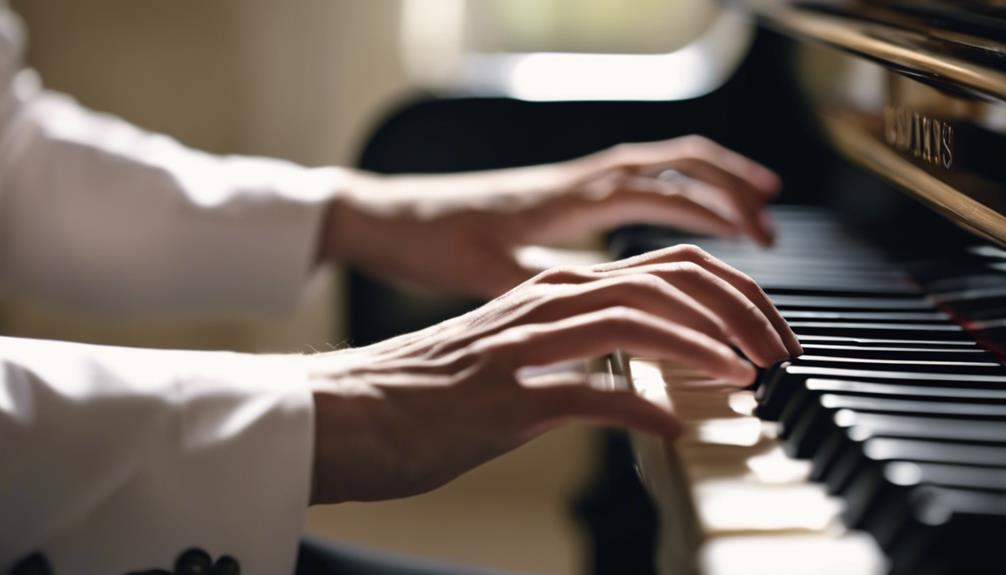When you start learning to play piano by ear, it’s important to develop your aural skills and begin with simple melodies.
You’ll need to listen deeply to music, identify basic chord progressions, and practice transposing songs into different keys. Enhancing your ear training and understanding fundamental music theory concepts are key steps in this journey.
By experimenting with different styles and consistently practicing, you’ll gradually improve. But how exactly do you choose the right songs and make your practice sessions effective?
Let’s explore the essential techniques and tools that can guide you towards mastering this skill.
TL-DR
- Start with simple melodies to develop your ear and confidence.
- Identify and practice common chord progressions to recognize patterns in songs.
- Enhance ear training with exercises and apps to improve note differentiation.
- Utilize basic music theory for understanding scales, intervals, and chords.
- Record and analyze your playing to track progress and identify areas for improvement.
Understanding Playing by Ear

Playing piano by ear means listening to music and replicating it without using sheet music. This process involves training your ear to recognize melodies, chords, and patterns in the music you hear.
Start by focusing on simple songs with clear, repetitive structures. These songs help you identify basic chords such as major, minor, and seventh chords. As you practice playing by ear, you’ll notice your listening skills improve, and you’ll begin to hear common chord progressions.
Understanding how different notes interact is essential for playing more complex pieces later on. To train your ear effectively, break down the music into smaller sections and play them repeatedly. Try to match the pitches and rhythms you hear with your piano keys.
Over time, this process will become more intuitive, and you’ll be able to play longer sections without stopping.
Choosing the Right Songs
Selecting the right songs is essential when you’re beginning to play piano by ear. Start with tunes that have a strong melody and a manageable tempo. A clear and distinct melody will make it easier for you to identify the notes and replicate them on the piano. Songs with complicated rhythms or intricate harmonies can be overwhelming for beginners, so keep it simple at first.
Before you attempt to play, listen to the song multiple times. Focus on the melody and try to internalize it. The more familiar you’re with the tune, the easier it will be to reproduce it on the piano.
Begin by learning and playing the right-hand melody. Don’t rush to add chords or harmonies with your left hand; mastering the melody is your first priority. Practice the melody until you can play it smoothly and accurately by ear. Repetition is key here. Over time, you’ll find that your ability to pick out melodies improves.
Listening to Music Deeply

To master playing piano by ear, you need to listen to music deeply, focusing on every detail of the melody and rhythm. Start by internalizing the melody of a song. Listen to it multiple times until you can sing along effortlessly. This helps you understand the song’s structure and nuances, which is vital when playing piano by ear.
Begin with simpler tunes like nursery rhymes. Their straightforward melodies make it easier to match the notes with the keys on your piano. Use trial and error to find the right notes. Play a note, see if it matches the melody, and adjust as necessary. This process might seem tedious at first, but it’s essential for developing your ear-training skills.
As you match the notes, repeat them often. This repetition helps you remember the notes and ensures you can play along with the song seamlessly. Pay attention to the rhythm and timing, too. These elements are as important as the melody when playing piano by ear.
Deep listening helps you develop a finer appreciation for music. With practice and patience, you’ll find that your ability to play more complex songs improves significantly.
Identifying Melodies
Now that you’ve honed your listening skills, it’s time to focus on identifying melodies accurately. When you play Piano by Ear, internalizing the melody is essential. Start by listening to a melodic song multiple times. This helps you to internalize the melody before attempting to replicate it on the piano.
Next, match the melody notes with the keys on your piano through a bit of trial and error. You’ll find that this process gets easier the more you practice. Focus on playing the right-hand melody first. This allows you to concentrate on getting the tune just right before adding the complexity of chords with your left hand.
Start with simple songs, like nursery rhymes. They build your confidence and make the process of learning to play by ear less intimidating. As you get better, gradually move on to more complex melodies.
Practice is key. Play the melody repeatedly until you can remember and play it smoothly and accurately. This repetitive practice embeds the melody in your muscle memory, making it second nature.
Recognizing Rhythms

Clapping or tapping along to the beat of a song helps you internalize its rhythm and understand the pattern of beats and accents. Start by focusing on the steady pulse of the music. This pulse is essential for grasping the overall rhythms of a piece. Once you’re comfortable, practice identifying different time signatures like 4/4, 3/4, or 6/8. These time signatures dictate the framework for the beats, helping you recognize how the rhythm is structured.
Next, observe the lengths of the notes. Determine if they’re played short or long, and see how they contribute to the song’s feel. This step is vital for understanding the relationship between notes, which impacts the flow of the music. Pay close attention to syncopation, where accents fall on off-beats instead of the main beats. Syncopation adds complexity and interest to rhythms, making the music more dynamic.
As you practice, try to internalize these rhythmic patterns. You’ll find that recognizing and replicating them on the piano becomes more intuitive. By mastering rhythms, you’re laying a strong foundation for playing piano by ear with greater confidence and precision.
Starting With Simple Tunes
Choosing simple tunes like nursery rhymes lets you ease into the process of playing piano by ear. These familiar melodies make learning piano more approachable and enjoyable.
Start by listening to the melody of the song multiple times. Pay close attention to the notes and how they flow from one to the next. This essential listening is vital for playing music by ear.
Once you’ve familiarized yourself with the melody, sit at the piano and try to replicate it with your right hand. Use trial and error to match the melody notes with the keys. Don’t worry if it takes a few tries – this is a normal part of the process. As you get better at identifying the melody, your confidence will grow.
Next, consider adding chords with your left hand to create harmony. For now, stick to simple chords that complement the melody. This step will help you understand the relationship between melody and harmony, a key aspect of playing songs by ear.
Starting with easy songs builds a strong foundation. As you become more comfortable, you’ll be ready to tackle more challenging tunes, enhancing your overall piano skills.
Using Your Right Hand

When learning to play piano by ear, focus on mastering the melody with your right hand by identifying and replicating the key notes. Start by listening carefully to the song and picking out the main melody. Use your right hand to find these notes on the piano, trying different keys until you match the sounds you hear.
Take your time with this process. Practice playing the melody slowly and accurately, ensuring each note is clear and in tune. Don’t rush; the goal is to make sure you’re hitting the correct notes consistently. Trial and error is your friend here. If a note doesn’t sound right, adjust and try again until you find the perfect match.
Begin with simple songs that have straightforward melodies. These will help build your confidence as you get used to playing by ear. As you become more comfortable, gradually move on to more complex tunes to really challenge and enhance your skills.
Repeat the melody with your right hand until you can play it smoothly and confidently without needing to look at any sheet music. This repetition will solidify your ability to play by ear and pave the way for more advanced techniques.
Adding Left-Hand Chords
To elevate your playing, start incorporating left-hand chords to complement the melody you’re mastering with your right hand. Adding left-hand chords can bring harmony and depth to your music, making it more engaging. Begin by practicing simple chords with your left hand. This allows you to build a solid foundation before tackling more complex chord progressions.
Focus on understanding the relationship between the melody notes and the chords you choose. Listen closely to how the melody interacts with each chord. You’ll notice some chords fit better than others, creating a cohesive sound. Experiment with different chord progressions to discover which ones enhance the melody you’re playing by ear.
As you practice, aim for smooth shifts between chords. This will guarantee your performance sounds seamless and polished. Start with basic major and minor chords before gradually incorporating more advanced ones. Pay attention to how each chord progression affects the mood and texture of the piece.
Experimenting With Chords

Now that you’re comfortable with adding left-hand chords, start identifying basic major and minor chords by ear.
Experiment with combining these chords creatively to enhance your melodies.
Try using different progressions and inversions to discover how they affect the overall sound.
Identifying Basic Chords
Explore experimenting with basic chords—major, minor, and dominant seventh—to understand their unique sounds and structures. When playing by ear, start by pressing the keys that form these piano chords.
Major chords usually sound bright and happy, while minor chords evoke a sadder, more melancholic feel. Dominant seventh chords add tension and a desire for resolution, which makes them essential in jazz and blues.
Begin with simple major and minor triads. For instance, if you play a C major chord (C-E-G), notice how it feels different from a C minor chord (C-Eb-G). Next, try a C dominant seventh chord (C-E-G-Bb) and observe its distinct character.
You can also experiment with chord inversions and voicings. Play a C major chord in its root position (C-E-G), first inversion (E-G-C), and second inversion (G-C-E). Each voicing offers a different harmonic texture.
Practice common chord progressions like I-IV-V in various keys. For example, in C major, play C (I), F (IV), and G (V). This will enhance your chord vocabulary and make shifts between chords smoother.
Use online resources and apps that provide chord charts and progressions to aid your practice.
Combining Chords Creatively
Immerse yourself in the art of combining chords creatively by experimenting with different progressions to craft unique and engaging harmonies. Start by playing the melody and exploring how different chord progressions can enhance or change its mood. Mix major and minor chords to evoke contrasting emotions, adding depth to your music.
Don’t just stick to standard chords; use inversions and extensions to add complexity. Inversions can make changes smoother, while extensions like 7ths, 9ths, and 13ths add a richer texture. For instance, try playing a C major chord in its first inversion (E-G-C) and notice how it feels different yet familiar.
Experiment with substituting chords within a progression to keep listeners on their toes. Instead of a simple I-IV-V progression, swap out the IV chord for a ii or vi chord to create unexpected twists. This can lead to surprising and delightful variations.
Additionally, explore different voicings and arpeggios to bring even more variety to your playing. Break up the chords and play the notes separately to add movement and interest.
Consistent Practice
To master playing piano by ear, you’ll need a consistent practice routine. Set aside time each day to play songs, track your progress, and focus on areas where you struggle.
This daily commitment will sharpen your ear and boost your confidence.
Daily Practice Routine
Carving out at least 30 minutes each day for focused piano practice will steadily boost your ability to play by ear. Establishing a daily practice routine is crucial for honing your ear training skills. Start each session by setting specific goals, such as identifying melodies, chords, and progressions by ear. This focused approach guarantees you’re consistently improving and not just playing aimlessly.
Utilize online resources and apps designed to aid in playing piano by ear. These tools can provide structured exercises and feedback, helping you stay on track. Additionally, experimenting with different genres and styles of music during your practice will broaden your ear training skills. Each style has unique characteristics that will challenge and refine your listening abilities.
Don’t forget to vary your practice techniques. One day, you might focus on a single melody, while another day, you could work on recognizing chord progressions. This variety keeps your practice sessions engaging and effective.
Track Your Progress
Tracking your progress is just as important as the practice itself when it comes to playing piano by ear. Setting specific practice goals is essential. They help you measure how far you’ve come and what you need to work on next.
Keep a practice journal where you record your daily efforts and improvements. Note down what pieces you played, what techniques you practiced, and any breakthroughs you had. This way, you can easily track your progress over time.
Consistent practice isn’t just about sitting at the piano every day; it’s also about being aware of your development. Use apps or online platforms to monitor your practice time and skill development. These tools can provide you with data on how often you practice and which areas you’re improving in.
Celebrate small victories and milestones to keep your motivation high. Whether it’s mastering a difficult piece or simply playing without mistakes for the first time, acknowledging these achievements can boost your confidence and keep you focused.
Focus on Weaknesses
Identifying your weaknesses in playing by ear is essential for making consistent progress. Whether it’s recognizing chords or matching melodies, knowing where you struggle allows you to focus your efforts more effectively.
Start by pinpointing the specific areas that challenge you the most. Is it the complexity of certain chords, or perhaps the difficulty in matching melodies accurately?
Once you’ve identified these areas, make them the focal point of your practice sessions. Consistent practice is key to overcoming these obstacles. Set specific goals for each session to target and strengthen your weaknesses.
For instance, if recognizing chords is tough, dedicate time to playing various chord progressions until they become second nature. On the other hand, if matching melodies is your weak spot, spend time listening and replicating simple tunes, gradually increasing the complexity as you improve.
Utilize online resources and tutorials tailored to these specific challenges. There are countless videos and exercises designed to help you improve in recognizing chords and matching melodies.
Developing Your Musical Ear

One of the most effective ways to develop your musical ear is by practicing differentiating between two notes. Start with ear training exercises that focus on identifying notes played consecutively. This foundational skill is important for playing by ear.
By regularly practicing these exercises, you’ll become adept at recognizing pitches and intervals, which is essential for figuring out melodies without sheet music.
As you progress, challenge yourself by identifying notes that are closer together. This will sharpen your listening skills and improve your precision.
Consider practicing with a friend or using apps designed for ear training. You can also enhance your musical ear by listening to songs and trying to identify the notes being played.
Regular ear training sessions not only make learning songs by ear easier but also more enjoyable. The more you practice, the more confident you’ll become in your ability to pick out melodies and harmonies.
Enhancing Your Skills
To enhance your skills, make sure you practice consistently every day and listen actively to music often.
Recording your progress can also provide valuable feedback and help you identify areas for improvement.
Practice Consistently Daily
Consistent daily practice is essential for honing your skills in playing piano by ear. By dedicating time each day to practice, you’ll improve your ear training skills, making it easier to recognize melodies and chord progressions. This daily routine turns abstract theory into practical knowledge and helps you internalize the nuances of different musical pieces.
When you practice consistently, you develop muscle memory, which is vital for playing familiar tunes without needing sheet music. Your fingers will naturally find the right keys, and your ears will better anticipate the next notes. This fluency makes your playing more intuitive and enjoyable.
Daily practice sessions also reinforce your understanding of music theory and chord progressions. As you repeatedly encounter these concepts, they become second nature. You’ll find yourself predicting chord changes and identifying common patterns in various songs, which greatly boosts your ability to play by ear.
Dedication is key. By committing to regular practice, you’re setting yourself up for success. You’ll gradually find that not only do you recognize melodies more effortlessly, but you also gain confidence in your ability to play complex pieces. So, carve out time each day and watch your skills flourish.
Listen Actively Often
Regularly listening to a variety of music genres sharpens your ear for different melodies and rhythms, enhancing your ability to play piano by ear. Engage in active listening by focusing intently on the details of the music. Notice the nuances in the melodies, the rhythms, and how the instruments interact. This will help you internalize various musical elements.
When you sing along to songs, you’re not just enjoying the music; you’re also training your ear. Singing helps you internalize the melody and understand the intervals between notes. These intervals are essential when you try to replicate what you hear on the piano. Pay attention to how high or low each note is compared to the one before it.
To further enhance your skills, use technology like apps or online resources that offer ear training exercises. These tools can help you practice identifying intervals and improve your pitch recognition.
Engage in regular ear training exercises to keep your listening skills sharp. By consistently practicing active listening, singing along, and focusing on intervals, you’ll find it easier to play piano by ear and develop a more intuitive understanding of music.
Record Your Progress
Start by using a recording device to capture your piano playing sessions, so you can track your progress over time. Listening to these recordings allows you to identify areas for improvement and refine your techniques. It’s a great way to enhance your ear training skills as you’ll be able to hear mistakes that might go unnoticed while playing live.
Analyze your recordings critically. Pay attention to timing, note accuracy, and dynamics. This self-assessment process is essential for spotting mistakes and understanding your strengths and weaknesses. By documenting your progress, you create a valuable learning tool that helps you continually improve.
Don’t just record the same song repeatedly. Challenge yourself by recording different songs and comparing your renditions. This variety ensures that you’re not only getting better at a single piece but improving your overall ability to play by ear.
Sharing your recordings with friends can be incredibly motivating. Not only will you be impressing your friends with your progress, but their feedback can provide additional insights. Use this feedback to further refine your skills. Over time, you’ll see just how much your playing has improved, making the journey all the more rewarding.
Using Music Theory

To play piano by ear effectively, you’ll need to grasp basic music theory concepts like scales, intervals, and chords. Understanding these elements will help you recognize and replicate the sounds you hear. Music theory is your roadmap when you play piano by ear, guiding you through the landscape of notes and harmonies.
Start by familiarizing yourself with common chord progressions, such as the I-IV-V, in various keys. This progression is prevalent in countless songs and will help you identify the underlying chords by ear. Knowing these patterns allows you to break down and understand the structure of different pieces more efficiently.
By applying music theory, you can analyze the harmony of songs, making it easier to play them by ear. Recognize how chords relate to each other and how they form the backbone of any melody. This knowledge also enables you to transpose songs into different keys confidently, ensuring that you can play along no matter the original key.
In essence, music theory equips you with the tools to understand the relationship between notes, chords, and progressions, enhancing your ability to play piano by ear with accuracy and confidence.
Playing With Friends
Playing with friends often makes ear training more enjoyable and effective. When you practice identifying notes and intervals with a friend, you can turn learning into a fun and collaborative experience. Start by challenging each other to play different notes on the piano and guess if they’re higher or lower. This simple game helps sharpen your listening skills, which are essential for anyone wanting to play piano by ear.
As you both become more comfortable, you can progressively increase the difficulty. Try identifying octaves and various intervals accurately. This not only improves your ear training but also deepens your understanding of the piano’s structure and sound. You’ll find that your ability to play piano by ear improves significantly when you practice with a friend regularly.
Playing with friends can transform a solitary activity into an engaging and competitive one. It breaks the monotony of practicing alone and adds a layer of accountability and motivation. The mutual support and camaraderie make the learning process more dynamic and less intimidating.
Selecting a Supportive Piano

While practicing with friends enhances your ear training, selecting a supportive piano is equally important for mastering this skill.
As a piano player aiming to learn how to play by ear, consider digital pianos like Roland’s, which offer onboard piano tones and Bluetooth connectivity. These features are excellent for ear training and accompaniment, allowing you to play along with your favorite tracks or instructional videos.
Utilize the onboard recorder available on many digital pianos to assess your progress. By recording your practice sessions, you can identify areas that need improvement and track your development over time. This feedback is invaluable when learning to play by ear.
A noteworthy feature to look for is Twin Piano mode, which lets you and a friend or teacher play two sections of the keyboard simultaneously. This mode is perfect for collaborative learning, making the process of mastering ear training more interactive and engaging.
Don’t overlook synthesizers, either. They offer a range of sounds and the ability to manipulate them, providing a versatile tool for experimenting with different tones and enhancing your ear training.
Lastly, watching experienced pianists on YouTube can help you visually learn hand positions and techniques, complementing your auditory learning process.
Next up, learn how to increase piano finger speed in this guide.
